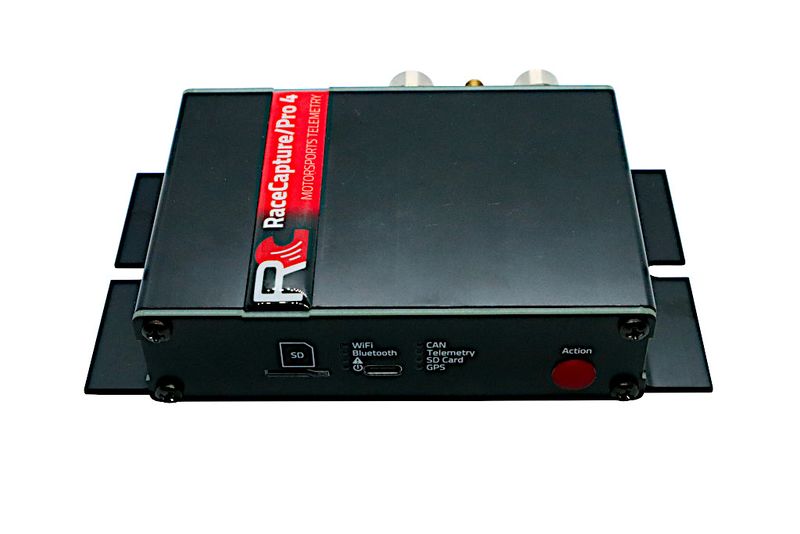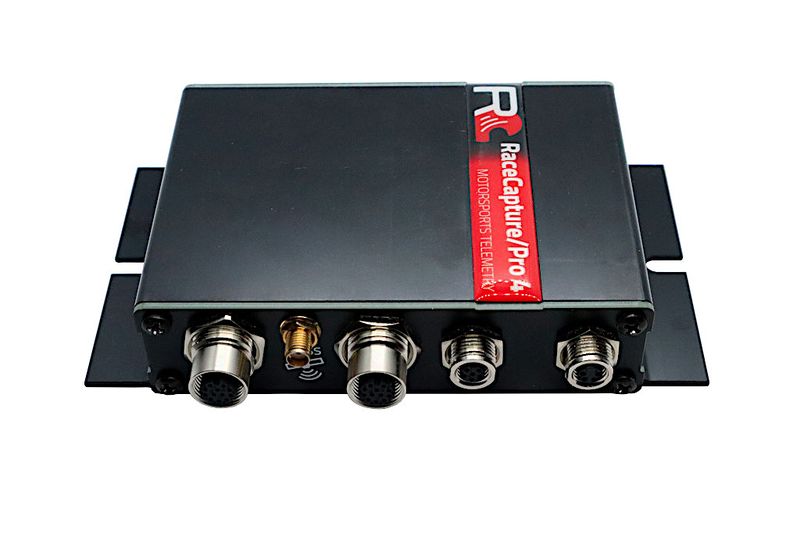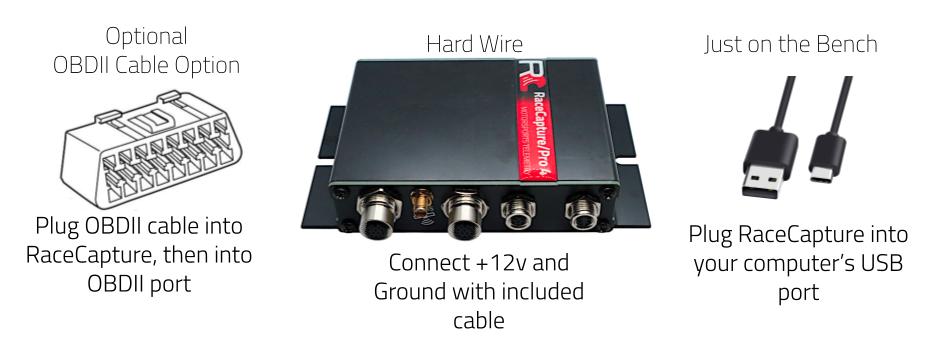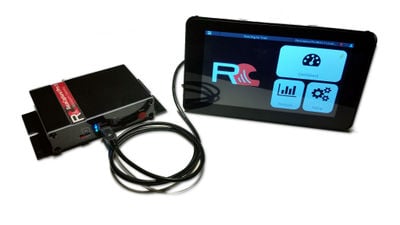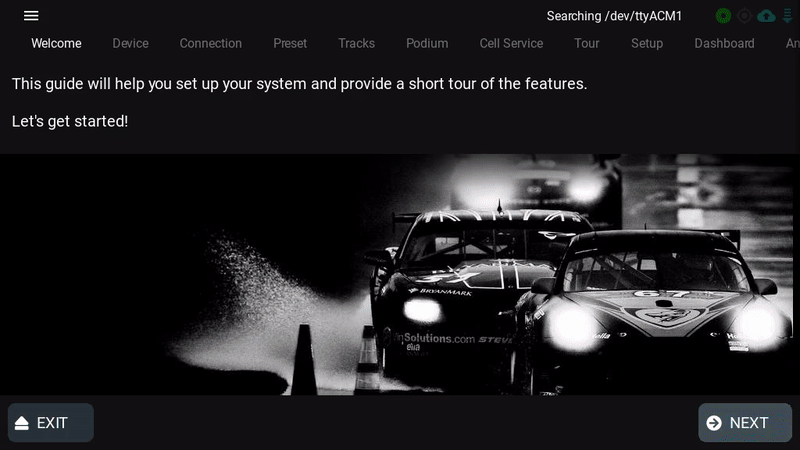RaceCapture-Pro MK4: Difference between revisions
| Line 300: | Line 300: | ||
| Power supply and Consumption (max) | | Power supply and Consumption (max) | ||
| System voltage: 9 - 24v (40v surge protection) / Power: Main System: 0.6W With Wireless: 1.6W With Cellular Telemetry: 8.6W With Cellular Telemetry and Wireless active: 9.6W | | System voltage: 9 - 24v (40v surge protection) / Power: Main System: 0.6W With Wireless: 1.6W With Cellular Telemetry: 8.6W With Cellular Telemetry and Wireless active: 9.6W | ||
|- | |||
| Recommended Fuse | |||
| 5A | |||
|} | |} | ||
Revision as of 17:07, 12 September 2023
Overview
RaceCapture/Pro MK4 is our latest generation motorsports telemetry system, packed with features for Endurance Racing, Sprint Racing, Autocross, Time Attack and more.
Guides
- Jump to quick start guide
- RaceCapture App user's guide
- Plug and play harness system for sensors and devices
- Vehicle Specific Guides
- Jump to Hardware guide
- Real-time Telemetry guide
- Logging Data
- CAN bus / ECU sensor guide
- OBDII Guide
- Sensor guide
- Lua scripting guide
- Lua script examples
- CoilX Tach interface to ignition coils guide
- Automatic Camera control guide
- Exporting to RaceRender guide
- Creating video with RCP data overlay using DashWare
- Data Analysis in Podium to become a faster driver
- Automating Tablets/Phones for use as Dashboards Guide
- TPMS guide
- General troubleshooting guide
How To
- How to: enable Predictive Timing
- How to: Submit a new race track
- How to: calibrate and configure an analog sensor
- How to: enable OBD2 channels
- How to: enable sequential shift lights
- How to control switches, relays, LEDS, etc from GPIO of Race Capture Pro
- How to: get best GPS data
- How to update firmware
- How to use multiple CAN systems with one ASL device
- Cool Projects, Cool Features, and Success Stories using Race Capture devices
- More FAQs and How-To's
- How To Videos
Reference
Quick Start
Powering Up
Using optional OBDII cable (2008+ vehicles)
- Plug one end of the cable into the RaceCapture unit
- Plug the other end of the cable into your car's OBDII port.
- Power and OBDII data will be provided to RaceCapture/Pro.
Powering via 12v
Plug the supplied power + CAN data pigtail into the RaceCapture system.
- Connect Red to 12v
- Connect Black to Ground
Testing on the Bench
You can power RaceCapture/Pro with just the included USB cable. Simply plug one end into your computer, and the other end into the USB connection on the front of the unit.
- Note: When powering only with USB, the voltage reference output will only be at approximately 4.7 volts, which can cause a mis-reading of sensor values. When precise sensor readings are required, provide 12v power to RaceCapture.
Install the RaceCapture app
On Desktop
USB Drivers
- Windows 10/11: Windows 10 has built in USB drivers that support RaceCapture; no separate driver installation needed.
- Windows XP, 7, 8: Not supported due to outdated video drivers, but may work depending on the video hardware used. USB drivers will require installation instructions below.
On Mobile
- Not sure what tablet to use? See our list of recommended tablets
On Raspberry Pi
More advanced users can run the RaceCapture App on a Raspberry pi for a more dedicated dashboard experience.
- Learn more in the Raspberry Pi Guide
Connect to your RaceCapture system (dashboard)
Use an Android, iOS or Raspberry Pi device as a dashboard in the car:
Bluetooth (Android Only)
In Android Settings, pair your device with the RaceCapture system.
- Note: Default bluetooth pin is 1234. You can change this later under Setup / Wireless in the app.
WiFi (iOS or Android)
In your mobile device WiFI settings, connect to the RaceCapture WiFi network.
- By default, RaceCapture will setup a WiFi network starting with 'RaceCapture', with no password. You can immediately connect to this network.
- Note: You can change the WiFi password later under Setup / Wireless in the app.
Launch the RaceCapture app
Once you've linked the Bluetooth or WiFi (Mobile), or USB (Windows or OSX) launch the RaceCapture app.
Automatic Setup and Verifying Connectivity
The RaceCapture app will guide you through a brief automated setup and tour. During this process the connection to RaceCapture/Pro will be verified.
Next Steps
Using the RaceCapture app
See the RaceCapture App User's guide for a full tour of using the app and setting up your system.
Connecting sensors and accessories
See the Plug and Play harness guide to learn how sensors and devices connect to your system
Specifications
| Sensors | |
| Analog Inputs | |
| Channels | 9 (8 external + 1 internal battery/supply voltage) |
| Voltage range | 0-5v |
| Input impedance | Greater than 1M ohm |
| Voltage Protection | 400v (intermittent) |
| ADC precision | 12 bit |
| Maximum sample rate | 1000Hz |
| Mapping | Raw / linear formula / interpolated map |
| Digital I/O | |
| Channels | 4 |
| Output mode type | Open Drain |
| Output current capacity | 1A, inductively clamped |
| Input mode voltage range | 0-12v |
| Input voltage protection | 0-40v |
| Maximum sample rate | 1000Hz |
| Timer inputs (RPM / Frequency) | |
| Channels | 4 |
| Voltage Protection | 400v (intermittent) |
| Maximum sample rate | 1000Hz |
| Mapping | RPM, Frequency |
| Voltage Reference | |
| Output Voltage / Capacity | 5v / 500mA |
| CAN Bus | |
| CAN Channels | 2 |
| CAN baud rate | 125K, 250K, 500K, 1M Baud |
| CAN filters | 14 per channel |
| Protocol Support | OBDII PID, custom CAN mapping |
| CAN Bus | CAN 2.0 compatible, 1M baud |
| CAN termination | Software controlled |
| Serial | |
| Aux Serial | RS232 |
| Max Baud Rate | 230400 |
| Cellular Telemetry (Optional) | |
| Optional Cellular | 4G LTE worldwide compatible |
| Maximum Sample Rate | 10Hz |
| Wireless | |
| WiFi | 802.11bgn |
| WiFi Modes | Access Point, Infrastructure |
| Bluetooth | Bluetooth 2.0 EDR |
| Maximum Sample Rate | 50Hz (Bluetooth and WiFi) |
| GNSS | |
| Constellations Supported | GPS, GLONASS, BeiDou, Galileo |
| Antenna Type | External active antenna |
| Sample Rates supported | 1 / 5 / 10 / 25Hz |
| Accuracy | 2.5M CEP |
| Inertial Motion Unit | |
| Accelerometer Channels | 3 (X/Y/Z) (2G, 4G capable) |
| Gyro Channels | 3 (Yaw/Pitch/Roll) (1000 degrees/sec) |
| Storage | |
| Micro SD | Up to 32GB (SDHC) |
| CAN bus direct mapping | 100 direct CAN mapping channels |
| Capabilities | |
| Channel Support | 200 |
| Predictive Lap Timing | Built-in |
| Track Mapping | Circut and point-point |
| Track maps | 200 built in for autonomous auto-detection; unlimited via RaceCapture app with interactive track map builder |
| Sectors per track | 20 |
| Logging file format | Plain CSV |
| Physical | |
| Dimensions | 150 x 100 x 30mm (5.9 x 3.35 x 1.18in) enclosure; 5mm mounting ears on 140mm centers; Enclosure body 85mm (connectors extend 15mm beyond main enclosure body). |
| Temperature range | -40 to 85c |
| Environmental | Connectors: IP67 / enclosure IP51 |
| Weight | 255g (12 oz) |
| Connectors | M12 12P female (Analog inputs); M12 12P female (Digital / RPM inputs); M8 6P female (CAN1/CAN2/Power); M8 4P female (CAN1/Power); SMA (GPS); RP-SMA (Cellular) |
| Power supply and Consumption (max) | System voltage: 9 - 24v (40v surge protection) / Power: Main System: 0.6W With Wireless: 1.6W With Cellular Telemetry: 8.6W With Cellular Telemetry and Wireless active: 9.6W |
| Recommended Fuse | 5A |

